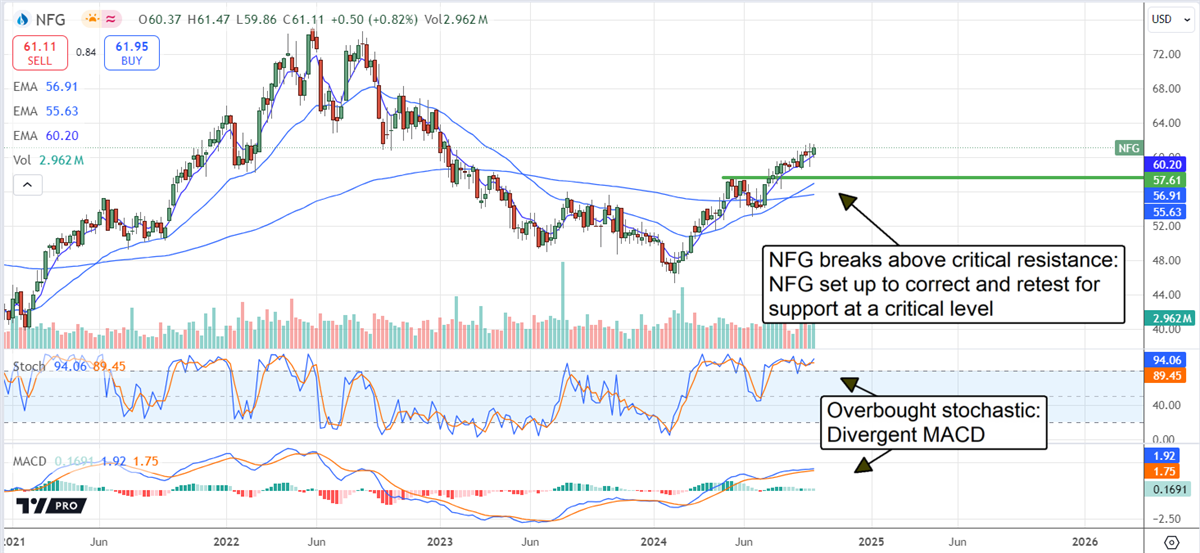- Congressional members have shown keen interest in National Fuel Gas stock, driven by compelling factors.
- This diversified energy player is strategically positioned to benefit from an anticipated surge in natural gas demand.
- With a robust balance sheet, National Fuel Gas is well-equipped to offer significant capital returns.
National Fuel Gas (NYSE:) stands out as a smaller yet versatile energy entity with a stronghold in the Appalachian region. The company is slated to hit a production mark of almost 400 billion cubic feet (BCF) by 2024, marking a substantial double-digit increase from the prior year, with growth momentum anticipated to spill over into 2025.
The company’s operational spectrum spans exploration, production, midstream and gathering services, as well as utility sales in Pennsylvania and New York. Despite dwindling natural gas prices contributing to revenue contractions, Congress remains deeply entrenched in its holdings, driven by optimistic outlook on natural gas demand growth, cash flow potential, and future capital returns.
As natural gas prices are projected to remain subdued in the coming years due to augmented supply, the silver lining emerges from the expected uptick in natural gas volume demand. National Fuel Gas is primed to navigate this terrain adeptly, well-poised to capitalize on heightened demand and generate substantial cash flow at present.
While declining prices may impact the production segment’s results, the mid and downstream segments are positioned to nullify this effect. Interestingly, the government-regulated segments are fortified by escalating base rates or the anticipation of such increments.
The Congressional Bet on National Fuel Gas
Congressional stakeholders have a sizable stake in National Fuel Gas, owning a hefty 532,000 shares of NFG stock, which translates to roughly 0.6% of the outstanding shares and 1.5% of the Subversive Unusual Whales Republican ETF (NYSE:). KRUZ, tracking Republican congressional members’ holdings, provides deep insights. Notably, NFG holds significant allocation relative to other energy positions, including Chevron (NYSE:), ConocoPhillips (NYSE:), and Shell (NYSE:), cumulatively constituting 5.5% of the portfolio, thereby positioning energy as a prominent sector within the group. In contrast, Democrats exhibit minimal ownership of energy-related stocks.
Although results in 2024 showcase a mix of growth in revenue juxtaposed with earnings contraction, the downturn has stabilized, with a return to growth envisaged. While natural gas prices linger at depressed levels, moving sideways near long-term lows, this lends a degree of stability to results even as production and deliveries witness growth. A long-term earnings growth projection of 10% annually over the forthcoming years is forecasted, adequate to sustain the robust balance sheet and facilitate capital returns.
Despite the earnings contraction, National Fuel Gas managed to secure a positive cash flow quarter, fortifying balance sheet health, dividends, and share repurchases. The recently initiated repurchase program trimmed the count by an average of 0.4% for the quarter to enhance the dividend, which remains sizable. The dividend outlay, elevated by 4% at the quarter’s end, currently hovers around 3.3%, with shares trading near an 18-month high. The dividend appears dependable, amounting to less than 40% of the earnings projection, and poised for a further boost in 2025. The balance sheet indicates robust financial standing, with net debt standing at less than 0.85x equity, solid cash reserves, and soaring equity, thereby signaling no imminent red flags.
The Sell-Side’s Stance on National Fuel Gas
According to MarketBeat.com’s data from Q3 2024, two analysts monitoring NFG stock assign it a Moderate Buy rating, projecting the stock to hover near its $62 floor. The consensus hints at a further 17% upside potential, possibly realizable in the near term, driven by institutional activity. Institutions have consistently displayed robust buying behavior towards this stock for eight consecutive quarters, with buying activities surpassing selling by a striking 3:1 margin. These institutional investors own roughly 75% of the shares and are likely to provide support to the stock price trajectory during fluctuations.
The stock price movement appears bullish, although a consolidation or short-term correction harbors certain risks. Encompassing an 18-month high, the market portrays overbought stochastic metrics and diverging MACD, signaling a potential vulnerability to weakness. Notwithstanding, substantial support is anticipated near the $57.50 level, mitigating downside risks and paving the path towards a potential technical entry point.

